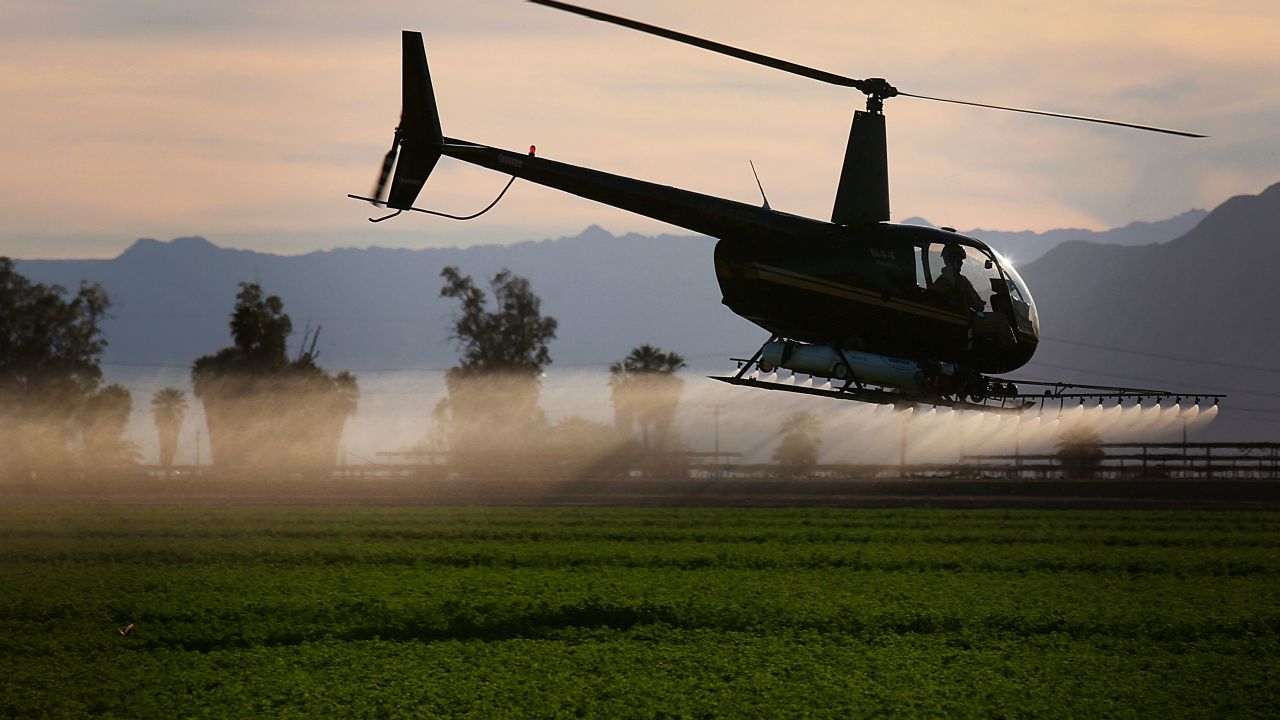
A helicopter sprays insecticide on a field outside of El Centro, California in the Imperial Valley on Feb. 11, 2015. The Imperial Valley has some of the poorest air quality in California due to border traffic, farming and other industries. (Photo by Sandy Huffaker/Corbis via Getty Images)
This post originally appeared at YES! magazine.
Each day, the drying Salton Sea and an increasingly busy border take their toll on the air quality of Southern California’s parched Imperial Valley. Despite averaging only 3 inches of rain a year, this swath of desert spanning the Mexican border from the Colorado River to San Diego County is heavily dependent on agriculture, and for decades farmers have relied on the Salton Sea to drain their fields. Today, the valley air hangs with toxic dust and pollution, and the residents face the highest rate of hospitalization for asthma of any area in the state.
“I wish I lived in an area where my kids could play outside any time of day,” said Esther Bejarano, a mother whose two children suffer from asthma. She is an educator for Comite Civico del Valle (CCV), a local organization that supports the health of the area’s disadvantaged residents. She knows the risks, regulates how much time her own children spend outside depending on the levels of pollution, and makes sure they have their medication and inhalers with them at all times. Despite taking these steps, she still lives in a state of fear. “I expect the worst and pray for their health.”
Even before Trump took office, government response to air pollution in the region has been lackluster. Luis Olmedo, executive director of CCV, said that especially as the recession came to a head in 2008, environmental health concerns took a back seat to economics, and it is now clear that environmental protection will not be a government priority. “With this administration we are back to the [George W.] Bush era, but we are ready and we are prepared, because we have been there before,” he said.
In 2013, the CCV began an effort to put the power of scientific data into the hands of community members. Through a partnership with the California Environmental Health Tracking Program and the University of Washington, and with funding from the National Institutes of Health, the Imperial Valley Air Quality Control project installed 40 air quality monitors throughout the valley and set up a website to gather pollution information and community-generated reports. The project’s goal is to track particulate matter — the hazardous sum of pollution that includes pollen, dust, smoke and soot — and inform residents of the presence and distribution of possible health risks.
“It gives the community a record on what the government is doing and not doing,” Olmedo said. That information can be used to hold agencies accountable and to inform local, state and national efforts. Olmedo is confident in the Imperial Valley community’s continued support. “We are not dependent on the federal government, and we never have been,” he said.
Residents of Imperial County are predominantly Hispanic and average about half the California per capita income, according to US census data. Due to the placement of highways and fossil fuel refineries, low-income communities of color throughout the nation are exposed to toxic pollutants at significantly higher levels than upper-income whites, and the CCV air quality control project sought to involve the most affected people from the outset to address this disparity. Imperial Valley residents worked with researchers to select locations to set up the air monitors. The online tool, called Identifying Violations Affecting Neighborhoods (IVAN), was launched in September and allows residents to access air quality information from each monitor, which update every 5 minutes, easily report an environmental issue and see others’ reports.
On Jan. 25, for example, a user submitted a report from El Centro: “Pesticide being applied while farmworkers harvesting.” The site admin then responded, “The [Department of Toxic Substances Control] Imperial CUPA has forwarded this complaint to the Imperial County Ag Commissioner’s Office Department of Pesticide Regulation.”
Farther west, San Diego County sits sandwiched between the Imperial Valley and the Pacific Ocean, and it also suffers from extreme levels of air pollution. The district of San Ysidro, located immediately north of the Mexican border, where an estimated 50,000 vehicles cross every day, is at particular risk. Last year, it devised its own community-based air quality project, based on and using the same low-cost monitors as the Imperial Valley project.
“The goal is less about seeing if communities meet those EPA standards and rather understanding where the hot spots are for pollution in the community,” said Edmund Seto, an associate professor with the University of Washington Department of Environmental and Occupational Health Services, who helped develop the air quality monitors. The two-year study, a partnership with the California EPA, the University of Washington and San Diego community organization Casa Familiar, is funded by a $225,000 grant, and currently operates 12 monitors throughout the San Ysidro area.
Results show that the border crossing is a notable hot spot. David Flores, Casa Familiar’s community development director, said his organization saw a rise in community involvement in 2007, three years after news broke that the federal government would spend $750 million to rebuild the San Ysidro border inspection facility. This renovation included new vehicle inspection procedures that created longer queues on the highway and more greenhouse gas emissions from idling vehicles. Flores said the federal government wouldn’t mitigate any of the adverse effects from pollution.
Thus, Casa Familiar led the community in developing bottom-up approaches, like the study, to protect themselves. “This study is putting the power in the community residents’ hands. This is their data,” said Vanessa Galaviz, a staff toxicologist with the California Office of Environmental Health Hazard Assessment. She said this is especially important for marginalized communities like San Ysidro.
Both Luis Olmedo, of Imperial Valley’s CCV, and David Flores, of San Ysidro’s Casa Familiar, were not worried about federal disinterest in climate justice. Their organizations are community-driven and sustained. And Flores is confident in the continued support of the state. “I think the state of California will continue to lead efforts of environment,” he said.
He hoped the results from the current study would qualify San Ysidro as an impacted community, opening the door for greenhouse gas reduction program funding from the state’s cap-and-trade proceeds. This would allow the community to take the next step, from monitoring pollution, to investing in sustainable housing and transportation to cut it back.




